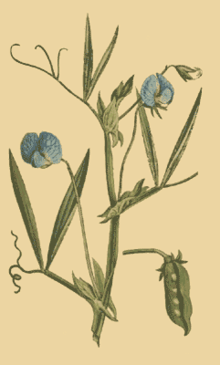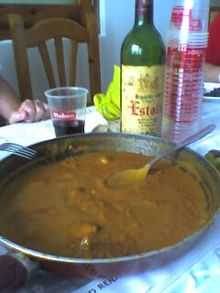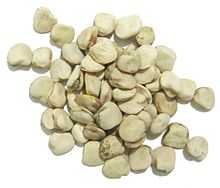Lathyrus sativus
| Lathyrus sativus | |
|---|---|
 | |
| Lathyrus sativus | |
| Scientific classification | |
| Kingdom: | Plantae |
| (unranked): | Angiosperms |
| (unranked): | Eudicots |
| (unranked): | Rosids |
| Order: | Fabales |
| Family: | Fabaceae |
| Subfamily: | Faboideae |
| Tribe: | Vicieae |
| Genus: | Lathyrus |
| Species: | L. sativus |
| Binomial name | |
| Lathyrus sativus L. | |
Lathyrus sativus, is a legume (family Fabaceae) commonly grown for human consumption and livestock feed in Asia and East Africa.[1] It is a particularly important crop in areas that are prone to drought and famine, and is thought of as an 'insurance crop' as it produces reliable yields when all other crops fail. The seeds contain a neurotoxin that causes a neurodegenerative disease when the seeds are consumed as a primary protein source for a prolonged period.
Synonyms
It is also known as grass pea, blue sweet pea, chickling vetch, Indian pea, Indian vetch, white vetch, almorta or alverjón (Spain), guixa (Catalonia), λαθούρι (Greece), chícharos (Portugal), cicerchia (Italy), ሰበረ, sebere (Eritrea), ጓያ, guaya (Ethiopia), and khesari (India).
Uses

Seed is sold for human consumption at markets in Florence. Consumption of this pulse in Italy is limited to some areas in the middle part of the country, and is steadily declining [citation needed].
Flour made from grass peas (Spanish:almorta) is the main ingredient for the gachas manchegas or gachas de almorta.[2] Accompaniments for the dish vary throughout La Mancha. This is an ancient Manchego cuisine staple, generally consumed during the cold winter months. The dish is generally eaten directly out of the pan it was cooked in, using either a spoon or a simple slice of bread. This dish is commonly consumed immediately after removing it from the fire, being careful not to burn one's lips or tongue.
Grass pea flour is exceedingly difficult to obtain outside of Castile-La Mancha, especially in its pure form. Commercially available almorta flour is mixed with wheat flour due to the fact that grass peas are toxic if consumed in significantly large quantities for prolonged periods of time.
Seed ODAP characteristics

Like other grain legumes, L. sativus produces a high-protein seed. The seeds also contain variable amounts of a neurotoxic amino acid β-N-Oxalyl-L-α,β-diaminopropionic acid or ODAP or BOAA.[3] ODAP is considered as the cause of the disease neurolathyrism, a neurodegenerative disease that causes paralysis of the lower body: emaciation of gluteal muscle (buttocks). The disease has been seen to occur after famines in Europe (France, Spain, Germany), North Africa, South Asia, and is still prevalent in Eritrea, Ethiopia and Afghanistan (pan handle) when Lathyrus seed is the exclusive or main source of nutrients for extended periods. Research has shown that ODAP concentration increases in plants grown under stressful conditions, compounding the problem.
Breeding programs are underway to produce lines of L. sativus that produce less ODAP.
References
- ↑ Oudhia, P. (1999). Allelopathic effects of some obnoxious weeds on germination and seedling vigour of Lathyrus sativus. FABIS Newsletter 42:32-34.
- ↑ Gachas manchegas recipe (Spanish)
- ↑ S. L. N. Rao, P. R. Adiga, and P. S. Sarma (1964). "The Isolation and Characterization of β-N-Oxalyl-L-α,β-diaminopropionic acid: A Neurotoxin from the Seeds of Lathyrus sativus". Biochemistry 3 (3): 432–436. doi:10.1021/bi00891a022.
External links
| Wikispecies has information related to: Lathyrus sativus |
- IPBO Lathyrus Research Laboratory
- Lathyrus newsletter
- Christopher McCandless - suspected poisoning from use of ODAP-containing Hedysarum alpinum seeds as a survival food